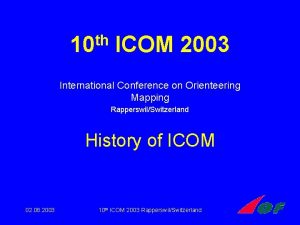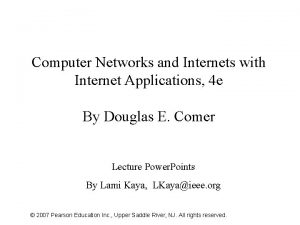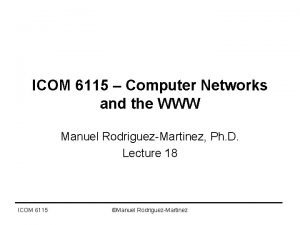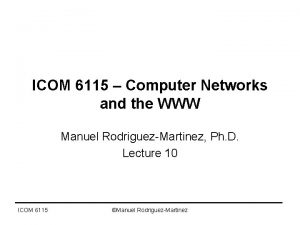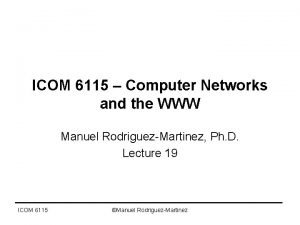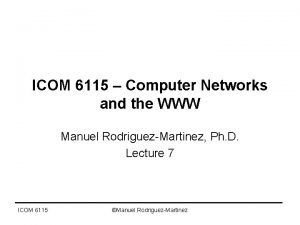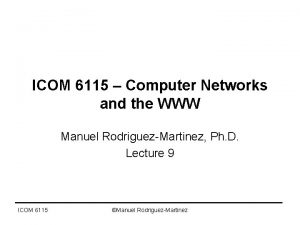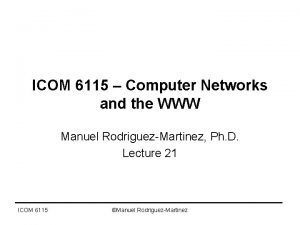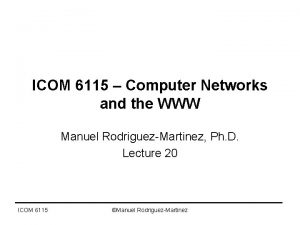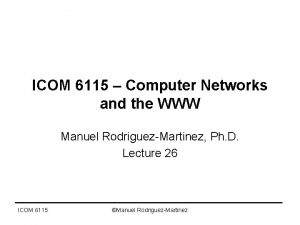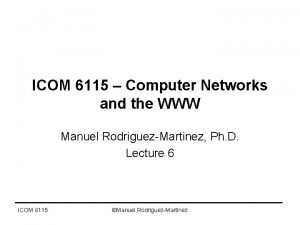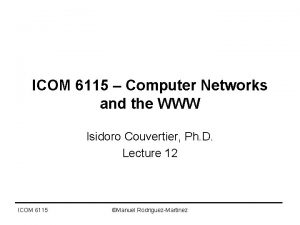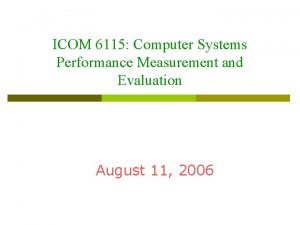ICOM 6115 Computer Networks and the WWW Manuel



















- Slides: 19

ICOM 6115 – Computer Networks and the WWW Manuel Rodriguez-Martinez, Ph. D. Lecture 22 ICOM 6115 ©Manuel Rodriguez-Martinez

Lecture Objectives • Introduction to Global Internetworking – Layer 3 – The Network Layer • Store-and-Forward Service – IP Protocol • IP addressing • ARP, ICMP • DHCP ICOM 6115 ©Manuel Rodriguez-Martinez

IP Addresses • Unique, Global identifier for a network card – Machines with multiple card get multiple IPs • e. g. routers • IP address is a 32 bit number – For simplicity, expressed in dotted-decimal notation • e. g. 128. 34. 5. 92 32 128 ICOM 6115 34 Bits 0 5 ©Manuel Rodriguez-Martinez 92

What are benefits of IP Addresses? • Hierarchical structure – Provide way to identify network and host • Ethernet are flat – Example: 135. 134. 9. 20 • Host 20 • Network 135. 134. 9. 0 • Routers need only to keep information about network – subnets ICOM 6115 ©Manuel Rodriguez-Martinez

IP Address Formats ICOM 6115 ©Manuel Rodriguez-Martinez

Special (Reserved) IP addresses ICOM 6115 ©Manuel Rodriguez-Martinez

Some Facts • Class A addresses – 7 bits for network, 24 bits for host • 126 Class A network, with roughly 2^24 hosts • Class B addresses – 14 bits for network, 16 bits for host • 64 K hosts on a Class B network • Class C addresses – 21 bits for network, 8 bits for host • 255 hosts a on a Class C network ICOM 6115 ©Manuel Rodriguez-Martinez

Issues: What’s in a forwarding table? • A router cannot deal with 64 K IP addresses in a table • Solution: Subnetting – Use the host part to identify areas of the LAN • Subnet – All host on a given subnet share: • Same network part of IP address • Same subnet part of IP address – Routers mainly store IP address of networks and subnets ICOM 6115 ©Manuel Rodriguez-Martinez

Example a Campus with Subnets ICOM 6115 ©Manuel Rodriguez-Martinez

IP address with subnets • MASK = Bit pattern that can be used to inspect certain bits on a byte, word, or array of byte • Subnet MASK – used to inspect the bits that indicate IP Address of the subnet Subnet mask is often written in dotted decimal notation e. g. 255. 252. 0 Also written in terms of bit length: /22 ICOM 6115 ©Manuel Rodriguez-Martinez

Examples • Suppose we have the network address – 130. 50. 0. 0 • 10000010 00110010 00000000 • Let the subnet mask be: 255. 252. 0 • The structure of the mask is • 1111111100 0000 • Subnets • 130. 50. 4. 0 - 11111111 00000100 0000 • 130. 50. 8. 0 - 11111111 00001000 0000 • 130. 50. 12. 0 - 11111111 00001100 0000 ICOM 6115 ©Manuel Rodriguez-Martinez

Sample LAN ICOM 6115 ©Manuel Rodriguez-Martinez

Forwarding Tables entries ICOM 6115 Subnet. Number Subnet. Mask Next. Hop 128. 96. 34. 0 255. 128 Interface 0 128. 96. 34. 128 255. 128 Interface 1 128. 96. 33. 0 255. 0 R 2 ©Manuel Rodriguez-Martinez

Datagram forwarding Algorithm D = destination IP address For each entry I = (Subnet. Number, Subnet. Mask, Next. Hop) in forwarding table T D 1 = MASK & D; // bitwise AND if D 1 == Subnet. Number if Next. Hop is an interface deliver datagram directly else deliver to next. Hop router ICOM 6115 ©Manuel Rodriguez-Martinez

More examples ICOM 6115 ©Manuel Rodriguez-Martinez

Issue how to map: IP address to MAC • ARP – Address Resolution Protocol – Sender broadcast a message asking host with IP X to reply with MAC address • Cached for later – Only that machine should reply – Other host will see the message and react • If they have MAC address of X in memory they will refresh it • Otherwise, they ignore it ICOM 6115 ©Manuel Rodriguez-Martinez

ARP Packet format ICOM 6115 ©Manuel Rodriguez-Martinez

Issue: IP addresses are scarce • To most sites Class A and C are not appropriate – Too many hosts or too little • Every body wants a Class B network address • Problem: Not enough IPs to go around • Solutions – IPv 6 – NAT ICOM 6115 ©Manuel Rodriguez-Martinez

NAT: Network Address Translation ICOM 6115 ©Manuel Rodriguez-Martinez
 Virtual circuit vs datagram networks
Virtual circuit vs datagram networks Basestore iptv
Basestore iptv Yaesu ftm-400xdr vs icom 5100
Yaesu ftm-400xdr vs icom 5100 Papasys
Papasys Icom
Icom Icom
Icom Intserv vs diffserv
Intserv vs diffserv Checksum in computer networks with example
Checksum in computer networks with example Bit and byte stuffing
Bit and byte stuffing Byte stuffing is also called as
Byte stuffing is also called as Rarp cisco
Rarp cisco Analog and digital signals in computer networking
Analog and digital signals in computer networking Web and http in computer networks
Web and http in computer networks Computer networks and internets with internet applications
Computer networks and internets with internet applications Transmission error in computer networks
Transmission error in computer networks Protocols and standards in computer networks
Protocols and standards in computer networks Crc example
Crc example Computer networks and internets
Computer networks and internets Crc in computer networks
Crc in computer networks Crc in computer networks
Crc in computer networks




